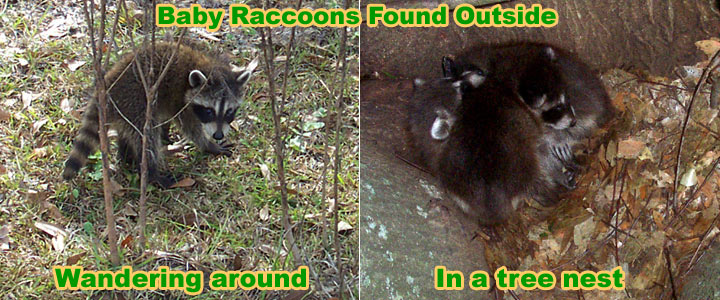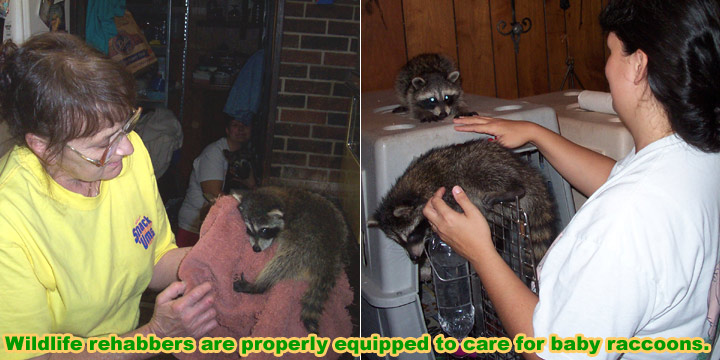A baby raccoon alone! - Should I do something? So you’ve stumbled across a cute, little, baby raccoon huddled endearingly somewhere near your home. If you’re reading this article, that means you’re
wondering what to do since the mother —who is nowhere to be seen— obviously must have been killed in a horrible hit-and-run on the nearby road. But wait…
that’s the first mistake people make.
A solitary, healthy, raccoon kit does not always mean an orphaned raccoon kit. It is very common for members of a litter to stray from the mother while she sleeps during the day. In fact, raccoons do not
become nocturnal until after one year of age, and a baby raccoon out and about could mean it fell from the den or was scampering around with a sibling only moments before your arrival. If you have found a
baby raccoon, do not immediately remove it from where you found it. If the mother is going to find her baby, she will do it within two to eight hours after it has been gone from the den. It is, however,
recommended that the baby be offered some protection while you wait for the mother to find it. Please wear gloves when handling a wild animal. This is for your protection against zoonotic disease, not because the mother will abandon it if she smells your scent.

A box with high sides and a warm water bottle will protect the baby from wandering off. A partial top will ensure the mother can retrieve the kit, but will offer protection from the weather.
Be careful not to make the
water bottle too warm! Baby animals are very sensitive to temperature.
Warm Water Bottle Tip: At the tolerable temperature for a baby animal, a soda bottle or commercial bottle with warm water will only stay warm for a few hours. If you fill your water bottle with rice instead
of water (make sure to poke a vent hole in the cap), you can microwave the rice for a few minutes and gain a few hours of heat retention. Wrapping the bottle with a sock will help the heat linger longer.
If you return to check on your charge the next day and the baby is still in the same location, you can assume it is orphaned. At this stage, to provide the kit with the strongest chances of survival, a wildlife
rehabilitator should be called. To find a raccoon rehabber in your area, click on my
nationwide directory of wildlife rehabbers or do an online search for one in your area. In the meantime, you can still care for the raccoon as advised below.
While you wait for help: It may go against every fiber of your being, but do not feed the baby raccoon that you have found. Many online resources recommend that puppy or kitten milk replacers can be substituted
for raccoon milk. This is true, BUT feeding a kit that is dehydrated, or feeding formula too quickly, can cause death. Instead of immediately feeding your raccoon formula, try to hydrate the animal first.
Electrolyte supplements, like Pedialyte for human infants, can be SLOWLY given by mouth to baby raccoons. Aspiration, the inhalation of liquid into the lungs, can happen if a kit is administered fluid too
quickly for it to swallow. DO NOT, under ANY circumstances, give cow milk to a baby raccoon.
What happens when the wildlife rehabilitator takes the raccoon? Raising an orphaned
wild animal is a very time-consuming, labor-intensive, daunting task. A rehabilitator will first assess that state of the kit.
If you have managed to hydrate the baby at home, the rehabilitator will begin the kitten milk replacer feedings. Baby raccoons are fed on their stomachs (not on their backs, remember—aspiration) and they are
fed at least five times during a 24 hour period. As raccoons will overeat, a wildlife rehabilitator will know when the stomach tension seems full after each feeding. Depending on the age of the kit, manual
stimulation of the bladder and rectum are required after feeding to encourage the baby to use the bathroom. In the wild, the mother raccoon would use her tongue to do this, teaching the babies what sensation
is accompanied by eliminating waste. A rehabilitator will do this using a warm, wet towel or cotton ball. After about eight weeks, the kit is ready to be graduated to canned kitten food, and eventually to fruits,
vegetables, and some chunks of dog or cat food.
Around ten weeks, the baby raccoon will be introduced to the outside world by the rehabilitator. This does not mean the baby is released into the wild. It is important for a young raccoon to learn about nature
before it is released on its own. Some rehabilitators teach baby raccoons to fish by offering a shallow pool stocked with minnows. Little by little, day by day, the raccoon will become more at home outside. When
the rehabilitator decides the time is right, the young adult will be released on state or protected land.

Now that you know what kind of time and dedication it takes to be a wildlife rehabilitator, you can understand why it is so important to support local rehab centers. Many states do not offer funding for private
rehabilitators, and any expenses incurred for wildlife care come directly from that individual’s own pocket. If you are lucky enough to have a rehabilitator, and have need of their services, consider making a
donation to help aid in the continued care of injured and orphaned wild animals.
Here are some other advice articles for wildlife rehabilitation:
What to do with a baby bat I found?
What to do with a baby deer I found?
What to do with a baby fox I found?
What to do with a baby opossum I found?
What to do with a baby raccoon I found?
What to do with a baby hawk or eagle I found?
What to do with a baby reptile I found?
What to do with a baby mouse or rat I found?
What to do with a baby songbird I found?
What to do with a baby squirrel I found?